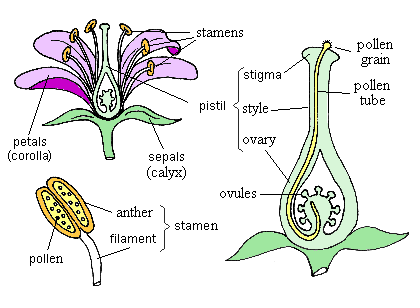MCQ ON Pistil Megasporangium and embryo sac for NEET |MCQ ON Pistil Megasporangium and embryo sac for NEET Biology class 12 th |MCQ Questions for class 12 Biology chapter 2, Pistil Megasporangium and embryo sac with answer | Check the below NCERT MCQ question for class 12 Biology chapter 2 based on Pistil Megasporangium and embryo sac with answers.
MCQ Questions for class 12 Biology with Answers were prepared based on the latest pattern. We have provided class 12 Biology MCQ questions on Pistil Megasporangium and embryo sac with answers to help students understand the concept very well.

Pistil Megasporangium and embryo sac
MCQ on is useful for NEET/ CSIR/ UGC/ CBSE/ ICSE /AIIMS EXAM/ AFMC EXAM/ JAC exam/ STATE LEVEL MEDICAL EXAMEXAM
Introduction:-
Pistil Megasporangium and embryo sac:-1. Pistil:-The pistil is the female reproductive organ found in the flower of angiosperm plants. It is typically located at the center of the flower and consists of three main parts: the stigma, the style, and the ovary. The stigma is the receptive surface where pollen lands, the style is the slender tube that connects the stigma to the ovary, and the ovary contains one or more ovules. The ovules are where the female gametophytes develop and where fertilization ultimately occurs, leading to the formation of seeds.
2. Megasporangium:-The megasporangium is a structure found within the ovule of a flower. It is the site where meiosis occurs, resulting in the formation of megaspores. Megaspores are large, haploid (n) cells that are essential for the development of the female gametophyte (embryo sac). The megasporangium provides the necessary environment and nutrients for the megaspore to develop into the female gametophyte, which plays a crucial role in fertilization and seed formation.
3. Embryo Sac:-The embryo sac, also known as the female gametophyte, is a structure that develops from a megaspore within the ovule of a flower. It is a multicellular structure that contains the female reproductive cells (egg cells) necessary for fertilization. The embryo sac typically consists of several cells, including one or more egg cells, synergids (which aid in pollen tube guidance), and antipodal cells. When pollen lands on the stigma and germinates, it forms a pollen tube that grows down through the style and into the ovary to reach the embryo sac. Fertilization occurs when the sperm cells from the pollen tube fertilize the egg cells within the embryo sac, resulting in the formation of an embryo, which develops into a new plant, and eventually, a seed.
MCQ ON Pistil Megasporangium and embryo sac for NEET
Here are 15 multiple-choice questions (MCQs) related to the pistil, megasporangium (ovule), and embryo sac in plants, along with their answers:
Pistil, Megasporangium, and Embryo Sac MCQs:
1. What is the primary function of the pistil in a flower?
a) Producing pollen
b) Attracting pollinators
c) Housing the female reproductive structures
d) Supporting the petals
Answer: c) Housing the female reproductive structures
2. The megasporangium is also known as:
a) Stamen
b) Ovule
c) Pollen grain
d) Filament
Answer: b) Ovule
3. In which part of the flower is the megasporangium (ovule) typically located?
a) Anther
b) Stigma
c) Pistil
d) Filament
Answer: c) Pistil
4. What is the primary purpose of the megasporangium (ovule)?
a) Producing pollen
b) Attracting pollinators
c) Producing seeds
d) Supporting the flower
Answer: c) Producing seeds
5. How many megasporangia are typically found within a single ovary of a flower?
a) One
b) Two
c) Three
d) Four
Answer: b) Two
6. During megasporogenesis, a megasporangium typically produces:
a) Megasporocytes
b) Microspores
c) Pollen grains
d) Sepals
Answer: a) Megasporocytes
7. How many megaspores are usually produced by a megasporocyte during megasporogenesis?
a) One
b) Two
c) Three
d) Four
Answer: a) One
8. The megaspore that survives and develops into the female gametophyte is called the:
a) Egg cell
b) Embryo sac
c) Pollen tube
d) Stamen
Answer: b) Embryo sac
9. What is the function of the embryo sac in plant reproduction?
a) Producing pollen
b) Attracting pollinators
c) Fertilizing ovules
d) Producing female gametes
Answer: d) Producing female gametes
10. How many nuclei are typically found in the mature embryo sac of a flowering plant?
a) One
b) Two
c) Three
d) Eight
Answer: c) Three
11. Which of the following cells is NOT typically found in the mature embryo sac?
a) Egg cell
b) Synergid cells
c) Antipodal cells
d) Pollen grain
Answer: d) Pollen grain
12. The fusion of a sperm cell with the egg cell in the embryo sac leads to the formation of the:
a) Zygote
b) Embryo
c) Endosperm
d) Sepal
Answer: a) Zygote
13. What is the primary function of the endosperm in plant seeds?
a) Protecting the embryo
b) Attracting pollinators
c) Providing nutrients to the developing embryo
d) Producing male gametes
Answer: c) Providing nutrients to the developing embryo
14. In a typical angiosperm flower, the pistil is composed of which parts?
a) Stigma, style, ovary
b) Anther, filament, petal
c) Sepal, pistil, ovule
d) Filament, stigma, embryo sac
Answer: a) Stigma, style, ovary
15. The pistil, megasporangium, and embryo sac are all essential components of the female reproductive system in:
a) Insects
b) Fish
c) Flowering plants (angiosperms)
d) Mammals
Answer: c) Flowering plants (angiosperms)
Conclusion:-
MCQ ON Pistil Megasporangium and embryo sac for NEET |How many nuclei are typically found in the mature embryo sac of a flowering plant?, a) One, b) Two, c) Three, d) Eight, Answer: c) Three







Leave a Comment